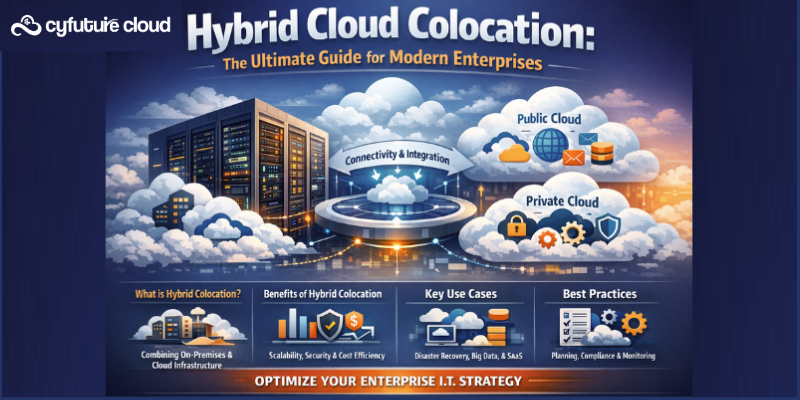Get 69% Off on Cloud Hosting : Claim Your Offer Now!
- Products
-
Compute
Compute
- Predefined TemplatesChoose from a library of predefined templates to deploy virtual machines!
- Custom TemplatesUse Cyfuture Cloud custom templates to create new VMs in a cloud computing environment
- Spot Machines/ Machines on Flex ModelAffordable compute instances suitable for batch jobs and fault-tolerant workloads.
- Shielded ComputingProtect enterprise workloads from threats like remote attacks, privilege escalation, and malicious insiders with Shielded Computing
- GPU CloudGet access to graphics processing units (GPUs) through a Cyfuture cloud infrastructure
- vAppsHost applications and services, or create a test or development environment with Cyfuture Cloud vApps, powered by VMware
- Serverless ComputingNo need to worry about provisioning or managing servers, switch to Serverless Computing with Cyfuture Cloud
- HPCHigh-Performance Computing
- BaremetalBare metal refers to a type of cloud computing service that provides access to dedicated physical servers, rather than virtualized servers.
-
Storage
Storage
- Standard StorageGet access to low-latency access to data and a high level of reliability with Cyfuture Cloud standard storage service
- Nearline StorageStore data at a lower cost without compromising on the level of availability with Nearline
- Coldline StorageStore infrequently used data at low cost with Cyfuture Cloud coldline storage
- Archival StorageStore data in a long-term, durable manner with Cyfuture Cloud archival storage service
-
Database
Database
- MS SQLStore and manage a wide range of applications with Cyfuture Cloud MS SQL
- MariaDBStore and manage data with the cloud with enhanced speed and reliability
- MongoDBNow, store and manage large amounts of data in the cloud with Cyfuture Cloud MongoDB
- Redis CacheStore and retrieve large amounts of data quickly with Cyfuture Cloud Redis Cache
-
Automation
Automation
-
Containers
Containers
- KubernetesNow deploy and manage your applications more efficiently and effectively with the Cyfuture Cloud Kubernetes service
- MicroservicesDesign a cloud application that is multilingual, easily scalable, easy to maintain and deploy, highly available, and minimizes failures using Cyfuture Cloud microservices
-
Operations
Operations
- Real-time Monitoring & Logging ServicesMonitor & track the performance of your applications with real-time monitoring & logging services offered by Cyfuture Cloud
- Infra-maintenance & OptimizationEnsure that your organization is functioning properly with Cyfuture Cloud
- Application Performance ServiceOptimize the performance of your applications over cloud with us
- Database Performance ServiceOptimize the performance of databases over the cloud with us
- Security Managed ServiceProtect your systems and data from security threats with us!
- Back-up As a ServiceStore and manage backups of data in the cloud with Cyfuture Cloud Backup as a Service
- Data Back-up & RestoreStore and manage backups of your data in the cloud with us
- Remote Back-upStore and manage backups in the cloud with remote backup service with Cyfuture Cloud
- Disaster RecoveryStore copies of your data and applications in the cloud and use them to recover in the event of a disaster with the disaster recovery service offered by us
-
Networking
Networking
- Load BalancerEnsure that applications deployed across cloud environments are available, secure, and responsive with an easy, modern approach to load balancing
- Virtual Data CenterNo need to build and maintain a physical data center. It’s time for the virtual data center
- Private LinkPrivate Link is a service offered by Cyfuture Cloud that enables businesses to securely connect their on-premises network to Cyfuture Cloud's network over a private network connection
- Private CircuitGain a high level of security and privacy with private circuits
- VPN GatewaySecurely connect your on-premises network to our network over the internet with VPN Gateway
- CDNGet high availability and performance by distributing the service spatially relative to end users with CDN
-
Media
-
Analytics
Analytics
-
Security
Security
-
Network Firewall
- DNATTranslate destination IP address when connecting from public IP address to a private IP address with DNAT
- SNATWith SNAT, allow traffic from a private network to go to the internet
- WAFProtect your applications from any malicious activity with Cyfuture Cloud WAF service
- DDoSSave your organization from DoSS attacks with Cyfuture Cloud
- IPS/ IDSMonitor and prevent your cloud-based network & infrastructure with IPS/ IDS service by Cyfuture Cloud
- Anti-Virus & Anti-MalwareProtect your cloud-based network & infrastructure with antivirus and antimalware services by Cyfuture Cloud
- Threat EmulationTest the effectiveness of cloud security system with Cyfuture Cloud threat emulation service
- SIEM & SOARMonitor and respond to security threats with SIEM & SOAR services offered by Cyfuture Cloud
- Multi-Factor AuthenticationNow provide an additional layer of security to prevent unauthorized users from accessing your cloud account, even when the password has been stolen!
- SSLSecure data transmission over web browsers with SSL service offered by Cyfuture Cloud
- Threat Detection/ Zero DayThreat detection and zero-day protection are security features that are offered by Cyfuture Cloud as a part of its security offerings
- Vulnerability AssesmentIdentify and analyze vulnerabilities and weaknesses with the Vulnerability Assessment service offered by Cyfuture Cloud
- Penetration TestingIdentify and analyze vulnerabilities and weaknesses with the Penetration Testing service offered by Cyfuture Cloud
- Cloud Key ManagementSecure storage, management, and use of cryptographic keys within a cloud environment with Cloud Key Management
- Cloud Security Posture Management serviceWith Cyfuture Cloud, you get continuous cloud security improvements and adaptations to reduce the chances of successful attacks
- Managed HSMProtect sensitive data and meet regulatory requirements for secure data storage and processing.
- Zero TrustEnsure complete security of network connections and devices over the cloud with Zero Trust Service
- IdentityManage and control access to their network resources and applications for your business with Identity service by Cyfuture Cloud
-
-
Compute
- Solutions
-
Solutions
Solutions
-
 Cloud
Hosting
Cloud
Hosting
-
 VPS
Hosting
VPS
Hosting
-
GPU Cloud
-
 Dedicated
Server
Dedicated
Server
-
 Server
Colocation
Server
Colocation
-
 Backup as a Service
Backup as a Service
-
 CDN
Network
CDN
Network
-
 Window
Cloud Hosting
Window
Cloud Hosting
-
 Linux
Cloud Hosting
Linux
Cloud Hosting
-
Managed Cloud Service
-
Storage as a Service
-
 VMware
Public Cloud
VMware
Public Cloud
-
 Multi-Cloud
Hosting
Multi-Cloud
Hosting
-
 Cloud
Server Hosting
Cloud
Server Hosting
-
 Bare
Metal Server
Bare
Metal Server
-
 Virtual
Machine
Virtual
Machine
-
 Magento
Hosting
Magento
Hosting
-
Remote Backup
-
 DevOps
DevOps
-
 Kubernetes
Kubernetes
-
 Cloud
Storage
Cloud
Storage
-
NVMe Hosting
-
 DR
as s Service
DR
as s Service
-
-
Solutions
- Marketplace
- Pricing
- Resources
- Resources
-
By Product
Use Cases
-
By Industry
- Company
-
Company
Company
-
Company
How Cloud Computing Can Benefit You?
Table of Contents
It has been almost two decades since cloud computing. But still, despite the statistics showing the cost-benefits, competitive advantages, and business efficiencies that cloud computing offers, a sizable portion of the corporate world still doesn’t use it.
According to research by International Data Group, “69% of businesses are now using cloud computing in some capacity, and 18% plan to do so in the future.“
Likewise, Dell notes that businesses that make investments in big data, cloud, mobility, and security outperform their rivals in terms of revenue growth by up to 53%. These data show that more and more tech-savvy businesses and business leaders are becoming aware of the many benefits of the cloud computing movement.
More than that, however, use this technology to run their organization more efficiently, better customer service, as well as dramatically increase their overall profits.
Did You Know?
“Approx 94% of business has claimed, post switching to the cloud, they saw a better improvement in security. Whereas 91% said the cloud makes it easier to meet the compliance requirements of government.”
All of this argues that there has never been a better moment to get your head in the cloud given the direction the business is now taking.
Well, the phrase “cloud computing” has become more well-known in recent years. People and organizations are finding it more and more difficult to keep all of their crucial information, apps, and systems up and running on internal computer servers as a result of the exponential rise in data use that has followed society’s transition into the digital 21st century.
Although the solution to this issue has existed for almost as long as the internet. Corporations have only just begun to benefit from it, however. In this blog, we are enlightening some major benefits of cloud computing. So, let’s come to the points directly.
What are the Core Benefits of Cloud Computing?
Here is a list of core benefits of cloud computing that organizations can expect while adopting cloud infrastructure. They are the following:
1. Instant Deployment:
Software development agility and speed have evolved. This is due to the speed with which fresh cloud computing instances are created. Developers may quickly test new concepts and construct application architecture without being bound by on-site hardware constraints or lengthy procurement procedures.
2. Integration and Automatic Software Updates:
Continuous integration and continuous delivery rely on the ability to easily test and deploy new software versions in the cloud environment. It also enables faster product creation and the deployment of more and more features to end customers on a monthly, weekly, and in some cases daily basis.
Furthermore, cloud environments integrate with common DevOps tools and logging software. Furthermore, this interface makes cloud setups easier to monitor and troubleshoot in production.
3. Cost Effective and Efficiency:
While utilizing cloud infrastructure, you don’t need to expend huge money for purchasing and maintaining equipment. Due to this, CAPEX and TCO are greatly decreased (TCO).
You don’t need to spend money on hardware, infrastructure, utilities, or the building of a sizable data center to grow your firm. You may rely on the expertise of the people at your cloud provider. So you don’t even require sizable IT teams to oversee your cloud data center operations.
Utilizing the cloud also lowers downtime expenses. You won’t have to spend time or money resolving any downtime concerns. This is because downtime is rare with cloud systems.
4. Scalability:
Businesses may easily scale up or down using the cloud system based on the situation and their changing demands. Additionally, using the cloud allows businesses to free up time that can be used to operate their operations.
5. Operational Continuity:
A key component of business continuity planning is data protection. In the event of a power outage or natural disaster, storing data in the cloud guarantees a secure backup of that data. The data is kept in a safe place and can be quickly accessed in an emergency, a business can continue as usual.
6. Flexibility in Work:
The employees get the benefit of remote work after the development in the cloud. Besides, it offers more flexibility to the employees. As a result, they can access the data more easily and quickly too.
7. Collaboration:
Cloud data storage benefits collaborating organizations. By using it, organizations can easily communicate rather than traditional ways of communication. The employees who are working from some other location can able to access the same files. Apart from all these things, cloud computing also developed secure data sharing with advisory or accountants.
8. Quality Control:
Poor quality and inconsistent reporting are the few things that affect the business’s success. Therefore, by using the cloud, all data, and files can store in a single format and location as well.
Consequently, it minimizes the chances of human fault, and also anyone can access the file further maintaining the consistency of data.
9. Easily Set Up:
The setup of cloud service is much easier than the traditional one. This is because all the data and files are stored and organized in the cloud. So, anyone can easily access it.
10. Flexibility:
Tasks may not be completed correctly or may fail as a result of the internal IT structure. The in-house IT sector is plagued by a serious problem with space optimization. This could lead to a quick turnaround time and the company’s inability to satisfy the customer’s needs.
The impact might be lessened with advances in cloud technology, giving businesses some flexibility. Due to the flexibility of the cloud, businesses may make alterations at the last minute and still function effectively. Furthermore, it would be ideal if the cloud system could make decisions quickly without worrying about how they might affect the IT infrastructure.
Final Thought:
In this era of digitalization, the cloud computing model has become a more essential part of any company. Organizations can choose the service they require according to their budget, the size of their organization as well as technical requirements. Although cloud computing plays a vital role in cost saving. And also helps the business operations of several organizations to lead at the top all over the world.
Recent Post

Stay Ahead of the Curve.
Join the Cloud Movement, today!
© Cyfuture, All rights reserved.
Send this to a friend

 Pricing
Calculator
Pricing
Calculator
 Power
Power
 Utilities
Utilities VMware
Private Cloud
VMware
Private Cloud VMware
on AWS
VMware
on AWS VMware
on Azure
VMware
on Azure Service
Level Agreement
Service
Level Agreement 


















